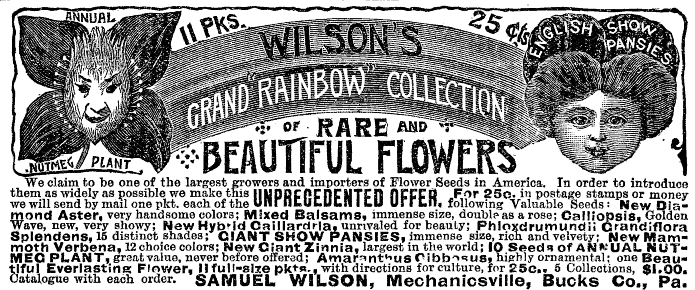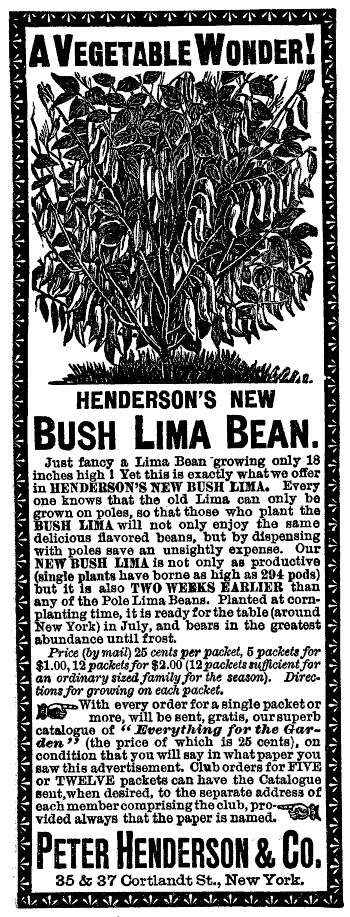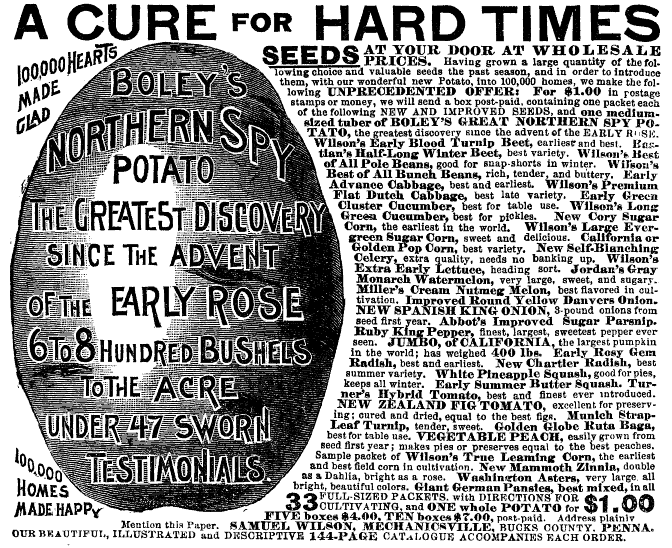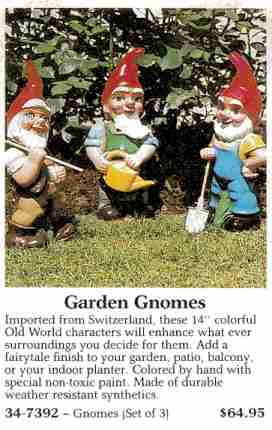(text only version)
The Seed Catalogue: A Comparative Study - page 3
by Clement Kent, 1991
THE MASS MARKET

THE MASS MARKETERS produce cheaply
printed, badly proofed, and often remarkably
misleading catalogues, some of them clearly in
violation of any truth-in-advertising laws.
Visually, these catalogues are a treat.
Full of implausibly coloured plants many times larger than one
will ever achieve in the garden, they threaten to
induce an altered state of dream-like, LSD-impaired perception. In this transfigured world,
tomatoes grow potatoes on their roots; enormous bunches of bananas adhere, unsupported, to tiny
house plants; apple trees transmute themselves into Christmas trees; carnivorous flesh-eating
plants snap and wave their deadly traps; the lawns and gardens behind them
glowing all the while in peyote- or mescaline-inspired colours.
These are the mass-produced analogues of illuminated manuscripts.
While the text sings the praises of the
product, the illustrations are bent and warped to fit - twisted around the supernatural
hardiness, vigour, and beauty of the sacred product like a honeysuckle around a monk's golden capital.
There is also the fervor, the manic enthusiasm of the religious convert in the descriptions, which,
of course, demand an equivalent act of faith from the reader.

 Whereas, in one sense, these catalogues are like religious tracts for deranged drug addicts, in
another, they're more like detective fiction, mysteries requiring the reader's sharpest wits to
solve. It becomes an amusing game to look for the sly misdirection, the cunning prestidigitation
by which a tender tropical vine is transformed
into a hardy sub-zero shrub. In general, their authors achieve such feats not by the simple
expedient of lying, which might after all be actionable, but by carefully choosing words that imply
yet never exactly state the dubious "fact". The
"Sub-Zero Hardy Lavender" bush does indeed survive temperatures below zero... Celsius. The
SuperSteak tomato entry is accompanied by a half-page drawing of an 18-inch-circumference
red blob, "bigger than a grapefruit", while above the drawing a caption says, "Pictured above less
than half size." The vigilant reader, puzzling over the word "above", eventually notices a
small, nondescript photo of a cluster of tomatoes beside the caption. They are certainly less than
half the size of a grapefruit - they are, in fact, half the size of a cherry. A bold-face heading
screams: "Challenge the World Record of a 6-1/4 Pound Tomato" while deep in the small
print is buried the comment "they are up to 2 pounds apiece." Just enough
photos are used, badly and fuzzily printed, to lead the reader to assume that the next illustration on
the page will be a photo too, when it's really an "artist's rendering" of a
plant that never existed. One such picture shows a pot filled with leaves of the "Rainbow Plant" in every
conceivable colour; hidden in very small print is the note: "Illustration shows multiple planting."
The "rainbow plant" is actually Caladium, whose leaves are all the same colour; the
"artist" has depicted leaves from at least a dozen different varieties, all apparently glued
together into one miraculous plant.
Whereas, in one sense, these catalogues are like religious tracts for deranged drug addicts, in
another, they're more like detective fiction, mysteries requiring the reader's sharpest wits to
solve. It becomes an amusing game to look for the sly misdirection, the cunning prestidigitation
by which a tender tropical vine is transformed
into a hardy sub-zero shrub. In general, their authors achieve such feats not by the simple
expedient of lying, which might after all be actionable, but by carefully choosing words that imply
yet never exactly state the dubious "fact". The
"Sub-Zero Hardy Lavender" bush does indeed survive temperatures below zero... Celsius. The
SuperSteak tomato entry is accompanied by a half-page drawing of an 18-inch-circumference
red blob, "bigger than a grapefruit", while above the drawing a caption says, "Pictured above less
than half size." The vigilant reader, puzzling over the word "above", eventually notices a
small, nondescript photo of a cluster of tomatoes beside the caption. They are certainly less than
half the size of a grapefruit - they are, in fact, half the size of a cherry. A bold-face heading
screams: "Challenge the World Record of a 6-1/4 Pound Tomato" while deep in the small
print is buried the comment "they are up to 2 pounds apiece." Just enough
photos are used, badly and fuzzily printed, to lead the reader to assume that the next illustration on
the page will be a photo too, when it's really an "artist's rendering" of a
plant that never existed. One such picture shows a pot filled with leaves of the "Rainbow Plant" in every
conceivable colour; hidden in very small print is the note: "Illustration shows multiple planting."
The "rainbow plant" is actually Caladium, whose leaves are all the same colour; the
"artist" has depicted leaves from at least a dozen different varieties, all apparently glued
together into one miraculous plant.

A diligent reader unfamiliar with the plants' scientific names can learn a great deal from
these imaginative and creative catalogues if she will but follow the one simple rule: assume the
given name is wrong or misspelled and try to guess the correct one. So regarded, the
mass-marketing catalogues become puzzle games with an educational goal: to teach the reader correct
plant identification while at the same time imparting the principles of modern surrealism.
There could be no better exercise than trying to identify a plant from a misleading and partial
description. And to avoid the pedantic rigidity of the taxonomist, these catalogues would teach us
the free-association techniques of Breton's Surrealist Manifesto. How else could the Smokebush,
Cotinus coggyria, turn into the "Carefree Royal Purple Smoke Tree, Colthus coggygrim" ?
(The "coggygrim" is most poetic, as is the license of the accompanying "artist's rendering", clearly
a third-grade student's version of a lilac, not a smokebush.) What boreal inspiration turned
the Scented Geranium, Pelargonium, into "Nature's Own Incredible Deodorizer Plant, Polargonium" ?
Devotees of that most typically modern genre of pulp literature, science fiction, will not find seed
catalogues lacking either. The technophile will revel in such space-age tools as
the "Earth auger", a helical bit that allows you to drill the soil of your garden with holes up to 3 inches
wide - if the extension cord on your electric drill will reach that far.
Or you might try the "Airless Electric Spray Gun", clearly intended for combatting alien pests in the
rigorous environment of space. Nor is biotechnology neglected, as the "Vegiforms" prove. These clear
plastic moulds quite literally press Mother Nature's fruits and vegetables (while they're still growing)
into service as classic kitsch lawn ornaments. Now your elves and gnomes can be made of fully
recyclable material - squash, eggplants, and melons - from your own garden.
Copyright 2001 by Clement Kent, c l e m e n t @ g o d e l . n e t

 Whereas, in one sense, these catalogues are like religious tracts for deranged drug addicts, in
another, they're more like detective fiction, mysteries requiring the reader's sharpest wits to
solve. It becomes an amusing game to look for the sly misdirection, the cunning prestidigitation
by which a tender tropical vine is transformed
into a hardy sub-zero shrub. In general, their authors achieve such feats not by the simple
expedient of lying, which might after all be actionable, but by carefully choosing words that imply
yet never exactly state the dubious "fact". The
"Sub-Zero Hardy Lavender" bush does indeed survive temperatures below zero... Celsius. The
SuperSteak tomato entry is accompanied by a half-page drawing of an 18-inch-circumference
red blob, "bigger than a grapefruit", while above the drawing a caption says, "Pictured above less
than half size." The vigilant reader, puzzling over the word "above", eventually notices a
small, nondescript photo of a cluster of tomatoes beside the caption. They are certainly less than
half the size of a grapefruit - they are, in fact, half the size of a cherry. A bold-face heading
screams: "Challenge the World Record of a 6-1/4 Pound Tomato" while deep in the small
print is buried the comment "they are up to 2 pounds apiece." Just enough
photos are used, badly and fuzzily printed, to lead the reader to assume that the next illustration on
the page will be a photo too, when it's really an "artist's rendering" of a
plant that never existed. One such picture shows a pot filled with leaves of the "Rainbow Plant" in every
conceivable colour; hidden in very small print is the note: "Illustration shows multiple planting."
The "rainbow plant" is actually Caladium, whose leaves are all the same colour; the
"artist" has depicted leaves from at least a dozen different varieties, all apparently glued
together into one miraculous plant.
Whereas, in one sense, these catalogues are like religious tracts for deranged drug addicts, in
another, they're more like detective fiction, mysteries requiring the reader's sharpest wits to
solve. It becomes an amusing game to look for the sly misdirection, the cunning prestidigitation
by which a tender tropical vine is transformed
into a hardy sub-zero shrub. In general, their authors achieve such feats not by the simple
expedient of lying, which might after all be actionable, but by carefully choosing words that imply
yet never exactly state the dubious "fact". The
"Sub-Zero Hardy Lavender" bush does indeed survive temperatures below zero... Celsius. The
SuperSteak tomato entry is accompanied by a half-page drawing of an 18-inch-circumference
red blob, "bigger than a grapefruit", while above the drawing a caption says, "Pictured above less
than half size." The vigilant reader, puzzling over the word "above", eventually notices a
small, nondescript photo of a cluster of tomatoes beside the caption. They are certainly less than
half the size of a grapefruit - they are, in fact, half the size of a cherry. A bold-face heading
screams: "Challenge the World Record of a 6-1/4 Pound Tomato" while deep in the small
print is buried the comment "they are up to 2 pounds apiece." Just enough
photos are used, badly and fuzzily printed, to lead the reader to assume that the next illustration on
the page will be a photo too, when it's really an "artist's rendering" of a
plant that never existed. One such picture shows a pot filled with leaves of the "Rainbow Plant" in every
conceivable colour; hidden in very small print is the note: "Illustration shows multiple planting."
The "rainbow plant" is actually Caladium, whose leaves are all the same colour; the
"artist" has depicted leaves from at least a dozen different varieties, all apparently glued
together into one miraculous plant.

